… so get up and get away….”For the month of July, Nestlé Brasil has unleashed a floating supermarket barge on the tributaries that thread deep into the Amazon region in an attempt to reach some 800,000 Brazilians living in isolated, riverside communities. “We are going to pick up the customer where he is,” announced Ivan Zurita, the CEO of Nestlé Brasil, in a statement. “This will be a service to the population of the Amazon, which has streets and avenues in the form of rivers.” Wherever the boat docks, locals can come aboard and wade through 1,000 sq. feet of supermarket space packed with more than 300 products, including chocolate, cookies, yogourt and ice cream. To meet the needs of poorer customers, Nestlé will sell smaller, more affordable packages of their branded foods and enrich them with nutrients to address deficiencies in local populations.”… “Its hard work but good money.”
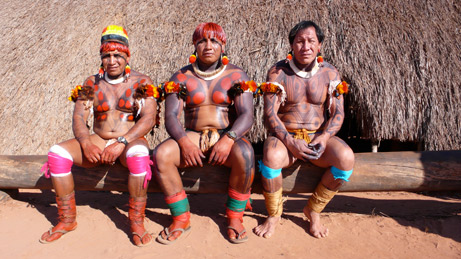
"Three Kuikuro Indians pose for documentary filmmakers in 2008 in Brazil’s Xingu Indigenous Park, a remote Amazon Basin refuge for traditional cultures. Centuries-old European explorers’ tales of lost cities in the Amazon have long been dismissed by scholars, in part because the region is too infertile to feed a sprawling civilization. But new discoveries support the idea of an ancient Amazonian urban network—and ingeniously engineered soil may have made it all possible."
Many regard the malevolent animals of the Amazon as both biological miracle, and pestilential horror, depending on your vantage point. The animals, however, seem to regard all humans as a square meal. Now, consumer goods multi-nationals are looking at Amazon natives as a square meal as well, using packaged Western sweets and transformed foods as a meal ticket to the hearts and loincloths of indigenous Amazon indians.
Teddy Roosevelt did much to dispel the myth of gigantic serpents by offering a reward of five thousand dollars to anyone who could produce the skin and vertebrae of an anaconda over thirty feet long. The reward, although an incalculable fortune in the debris of the rubber boom, was never claimed. In the absence of any specimen of such modest dimensions one can safely conclude that the anaconda seldom, if ever, grows longer than thirty feet, and accounts of monsters more than twice this length are fantasy.
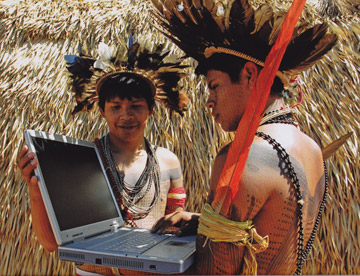
---At the forefront of this effort is the Amazon Conservation Team (ACT), a Virginia-based group with field offices in Brazil, Suriname, and Colombia. the Amazon Conservation Team has pioneered geographic information system (GIS) training of indigenous groups in the Amazon to enable them to map their land, not only as a means to demarcate it and win title, but to catalog their cultural links to the land. In building these “cultural maps,” tribes construct maps of their territory that go beyond the topography of the terrain, capturing the underlying richness of generations of human experience, including their interaction with the land and other tribes, and the distribution of plants and animals of nutritional, medicinal, and spiritual significance.---
Any chronicle of Amazonian horrors would be incomplete if it did not include the vampire bat. These creatures are repellant at best, and at their worse are an insidious menace. The vampire’s victim will awake in the morning, having slept normally, to find one end of his hammock and the ground underneath it soaked with blood. On further examination they will find a small conical hole in their body, usually on one of the extremities, a toe, a finger, or the tip of the nose; this wound will clot very slowly. The entry of the vampire’s tooth should be painful enough to awaken its victim, and why it fails to do so is an unsolved mystery. Naturalist after naturalist has bled without waking, even when the wound was in as sensitive a part of the body as the lip or the nose.
The ability to attack without being noticed makes the vampire bat difficult to study, and it was not until Darwin one bleeding a horse that its species was correctly identified. Earlier naturalists had blamed the attack on a large and hideous looking bat, which was in fact quite harmless and which suffered much persecution as a result of the mistake. The real vampire was far smaller and looked comparatively benign.

Julia Belluz:While clever, the remote marketing Nestlé is undertaking in the Amazon is not unique. Companies such as Coca-Cola, Avon and Wal-Mart have been targeting the developing world for decades, and Unilever has already made gains in Brazil, creating a distribution network in the country’s shantytowns. But critics warn that Nestlé must tread softly. Michele Simon, the author of Appetite for Profit, argues that the introduction of sugary foods may exacerbate obesity rates and health problems—something akin to the epidemic in the northern hemisphere. “If there are people out there so backwards to still be subsisting on food found in nature,” she writes, “Big Food will find them, by land or by sea.”
In some places life became almost insupportable because of the vampire’s raids. One bloodletting does little harm to a mammal as big as a horse, an ox, or a man, but the cumulative effect of regular attacks can debilitate and eventually destroy the strongest creature. On Mexiana Island, in the mouth of the Amazon, Alfred Russel Wallace found that many cattle had been bled to death, and at Sao Gabriel on the Rio Negro, Richard Spruce saw one miserable soldier with eight separate wounds in his big toe. While the vampire could be a serious threat, one could always avoid it by moving a few miles away or by taking a few elementary precautions.
Both Spruce and Wallace escaped being bitten by wrapping up well at night and leaving no flesh exposed. A light left on all night was also a fairly efficient deterrent, but the most effective countermeasure was found by a family in Sao Gabriel who, like everyone else in the village, had suffered terribly each night. One evening by a happy mistake they allowed their cat to stay inside. The next morning they found that no one had been bitten and that there were several dead bats on the floor. After this, they kept the cat in every night, and a vampire bat had only to alight on a hammock to be struck down at once.
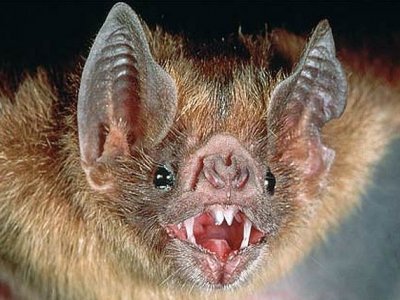
Charles Waterton:At the close of day the vampires leave the hollow trees whither they had fled at the morning's dawn and scour along the river's banks in quest of prey. On waking from sleep the astonished traveller finds his hammock all stained with blood. It is the vampire that hath sucked him. Not man alone but every unprotected animal is exposed to his depredations; and so gently does this nocturnal surgeon draw the blood that instead of being roused the patient is lulled into a still profounder sleep. There are two species of vampire in Demerara and both suck living animals: one is rather l
r than the common bat the other measures above two feet from wing to wing extended. --ADENDUM:
Michele Simon: Plenty of food activists are expressing concerns over how the developing world is fast becoming the dumping ground for Big Food. Hank Herrara, food justice advocate in Oakland, Calif, notes a particular irony in how the rainforests of Brazil are being destroyed to make way for the manufacture of more and more highly processed foods, while native diets are getting shunted aside:
We can be assured that the industrial food giants will dispense their wares in places now blissfully ignorant of what they are missing. I’m sure Nestlé feels confident that the consumer packaged goods coming off these boats are much better for the people than their own indigenous diets, whatever is left of those diets after the land has gone into soybeans for the American market, which produces consumer packaged goods for the global market….Oh, I get it now…..
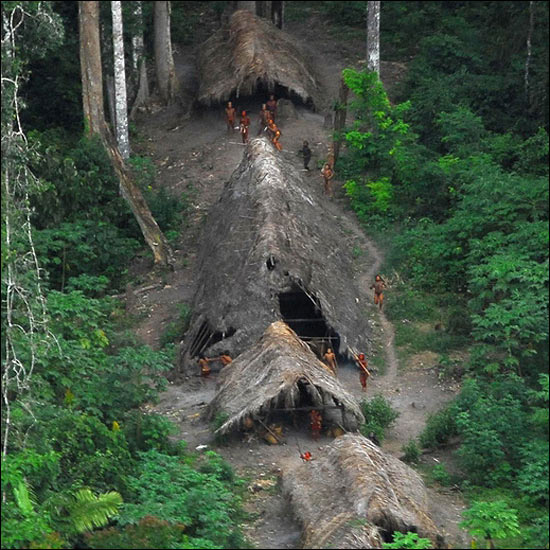
"---Recent photos of an "uncontacted tribe" of Indians near the Brazil-Peru border have sparked media reports of a hoax, but the organization that released the images defends its claims and actions. The photographs, which showed men painted red and black and aiming arrows skyward, were released in late May by Survival International, a London-based organization that advocates for tribal people worldwide. The release stated that "members of one of the world's last uncontacted tribes have been spotted and photographed from the air,"---
Gonçalves says that promoting junk food to poor people has been taking place in Brazil for a long time, and not only in Amazon regions. “Big companies such as Nestlé have been selling products in many favelas [shanty towns] all around the country, but especially in big cities like São Paulo and Rio de Janeiro. As the economy is stabilized, the lower classes now represent a large new market. And these companies want to take advantage and conquer these new consumers,” she said.
Allen L. Hammond: Perhaps the greatest misperception of all is that selling to the poor is not profitable or, worse yet, exploitative. Selling to the world’s poorest people can be very lucrative and a key source of growth for global companies, even while this interaction benefits and empowers poor consumers. Sweet smell of success: An Avon lady peddles deodorant to Tembe Indians in Brazil’s Amazon basin….In 1993, when Avon sent an army of direct-selling cosmetics merchants paddling up Amazon tributaries to sell perfumes and makeup to miners and prostitutes, Avon ladies answered only to themselves. Today, direct sellers arriving to “Avon-gelize” remote Indian villages are subject to sanctioning by an Indian judge-effectively a corporate ombudsman-if they break a code of ethics formulated by the Indian Direct Selling Association. (The code aims to weed out “fraudulent elements” among direct sellers and prevent pyramid schemes.)
a


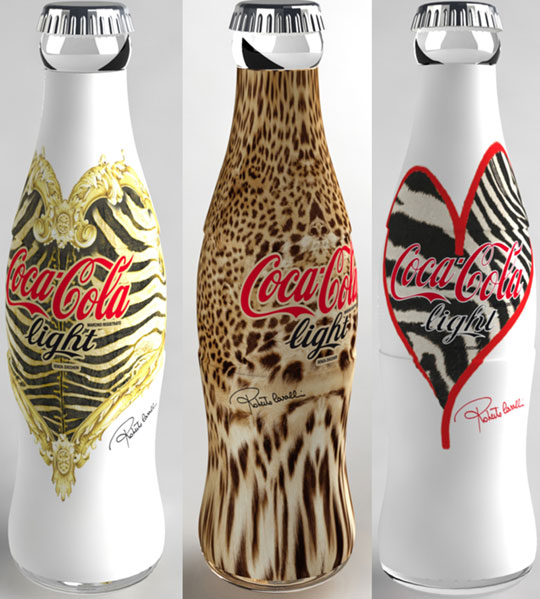



 COMMENTS
COMMENTS